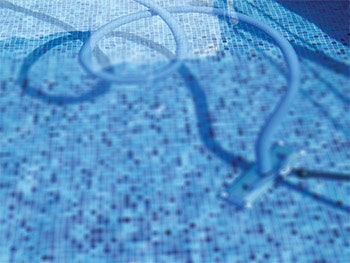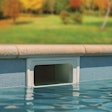
Today’s pool professionals have learned to incorporate robotic automatic pool cleaners into their service routines and retailers are frequently selling the units to their pool owner customers. With so many automatic pool cleaners in the market, pool professionals must now be versed in how to troubleshoot common problems and user mistakes when using the product. Like any robotic product, there are some common user errors and sometimes-faulty parts that cause an automatic pool cleaner to malfunction. This article provides troubleshooting solutions for pool professionals and pool retailers when automatic pool cleaners aren’t working properly.
What are some of the causes of automatic pool cleaners that “flip” upside down or do “wheelies?”
The water level in a pool is one of the most common causes for automatic pool cleaners to flip over. When the water level on the skimmer is too high, the water line is too close to the coping. So when the automatic cleaner starts to climb up the pool wall, it hits the coping and flips on to its back. This is actually very detrimental to the motor(s) on the cleaner because the motor is no longer in the water – but exposed above the water. The motor of the robotic cleaner is cooled by the water, so having it run out of water allows it to get hot and fail. Depending on the temperature of the day, the motor could also fail as fast as within one hour. (If it’s really hot, say 90 degrees, it only takes a matter of minutes).
When a homeowner first uses an automatic cleaner, they often forget to remove all of the air in the unit before starting the machine. Not only can this cause flips and wheelies, but it also keeps the cleaner from performing correctly. This happens the first time they use the unit, but even after releasing trapped air, if some remains, the unit tends to ‘float’ sometimes just an inch above the floor — so it looks like it might be working as it moves forward, but it isn’t touching the floor to actually clean.
It can take up to 30 minutes to remove all of the air. One must hold the unit under the water and shake it from left to right and up and down — watching the water bubbles come out. Then one must carefully watch that the unit actually hits the shallow end floor.
Remember also that there is the possibility that the pump motor is weak or turning too slowly, so the only solution might be to replace the motor.
Here are some similar, specific complaints:
PROBLEM: Robot does not lay flat on the pool floor
Most likely, the PVA (polyvinyl alcohol) brushes have not absorbed the water. This is a very common call and easy to fix. Simply let the automatic pool cleaner sit in the pool for at least 30 minutes or until brushes are soft. Once the brushes are soft, the unit will lay flat on the pool floor.
PROBLEM: Robotic cleaner will not climb walls
Sometimes the solution to this problem can be as simple as ensuring the pool water isn’t too cold. In order for the robotic cleaner to operate correctly, the water needs to be at least 60 degrees Fahrenheit. Water can also get into the handle, which may cause the unit to lift brushes from the wall and break the suction, making the unit fall to the bottom. Users should try to place the handle at an angle to remove the water so unit can climb the wall, or if that doesn’t work, check to see if the handle needs to be replaced. If the temperature is above 60 degrees Fahrenheit and the handle doesn’t have water in it, then there is also the possibility that the pump motor or propeller is defective. If this is the case, you will likely see an early shut down of the unit and the pump motor will need to be replaced.
PROBLEM: Robotic cleaner falls backward off the pool wall
The most likely cause is water in the handle of the unit. If the handle is cracked, water will leak in and disrupt normal operation. To determine if there is water in the handle, simply remove the unit from the pool, place it on the pool deck and move the handle back and forth while listening for sloshing water.
PROBLEM: Robotic cleaner will not or moves in short, jerky motions
Though it’s obvious, be sure that the power supply is connected properly to the power outlet. If the unit moves in short, jerky motions the unit could have a deteriorated drive belt, which can be simply replaced to solve the problem. Debris could also be stuck in the drive pulleys, so it’s important to inspect for and remove any debris before retrying the unit. If the pulley teeth are filled or missing, replacing the pulley is another easy solution. It’s also important to check the wear and tear of brushes and drive tracks, which can also become worn with use and need to be replaced. Lastly, check to see if the bottom lid assembly is properly secured, as it could be dragging on the pool floor and causing irregular movements. Simply turn over the unit and secure the lid. Worse case: the unit may need new lock tabs.
What tips can you offer to ensure the full life of the cleaner motor? What are some of the common causes of motors that burn out prematurely?
Overheating of the motor is the No. 1 problem. This can be caused by several factors.
Pools with beach entry should use an automatic cleaner with a pump motor that has a “beach boy” (or similar) feature — it’s a sensor that detects zero-depth water and prevents the cleaner from exiting the water. Without this type of feature, an automatic pool cleaner can simply travel out of the pool and down the deck or down the street. The motor is sure to fail due to overheating, as motors require the water to cool the electrical motor. Some units feature “air sensors” that tend to fail because they use additional wiring that will corrode from moisture exposure, or the mechanical parts get clogged and stuck. Try to choose a cleaner with a drive motor that senses voltage draw from the pump; when the voltage draw drops, the drive motor assumes the machine is out of the water and reverses its direction. This way, there is no way for the motor to get out of the water, overheat and fail.
What are some of the most common technical problems and solutions that users and pool professionals will likely find themselves troubleshooting daily/weekly?
This time of year, the calls come from parts of the country that are warm enough NOT to close the pool for the winter — but their pools are not being used by swimmers, so the water is cold! As mentioned previously, water below 60 degrees Fahrenheit will keep a cleaner from operating correctly.
If any of these problems turn out to be issues that fall under warranty or require repair, be sure to check with the manufacturer of the product as they likely will have a certified service center where the units are sent in for repair.
Ultimately, automatic robotic pool cleaners are here to stay and benefit our industry. For service technicians, integrating robotic cleaners into your work routine means you can spend less time cleaning the pool and more time doing profitable service repair work or cleaning more pools per hour. For retailers, selling automatic pool cleaners is a terrific way to ensure your clients are spending more time enjoying their pools instead of maintaining their pools.











































